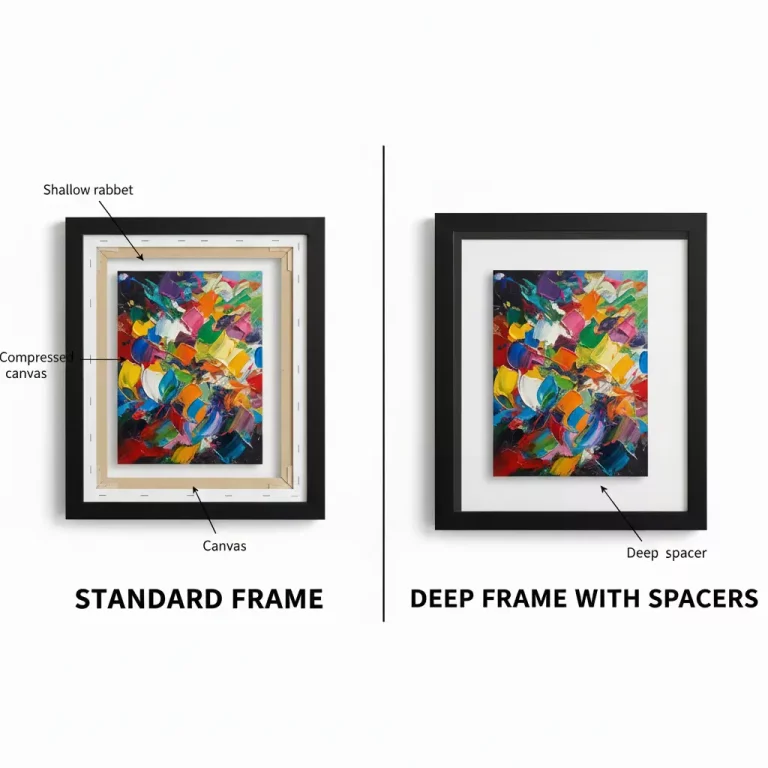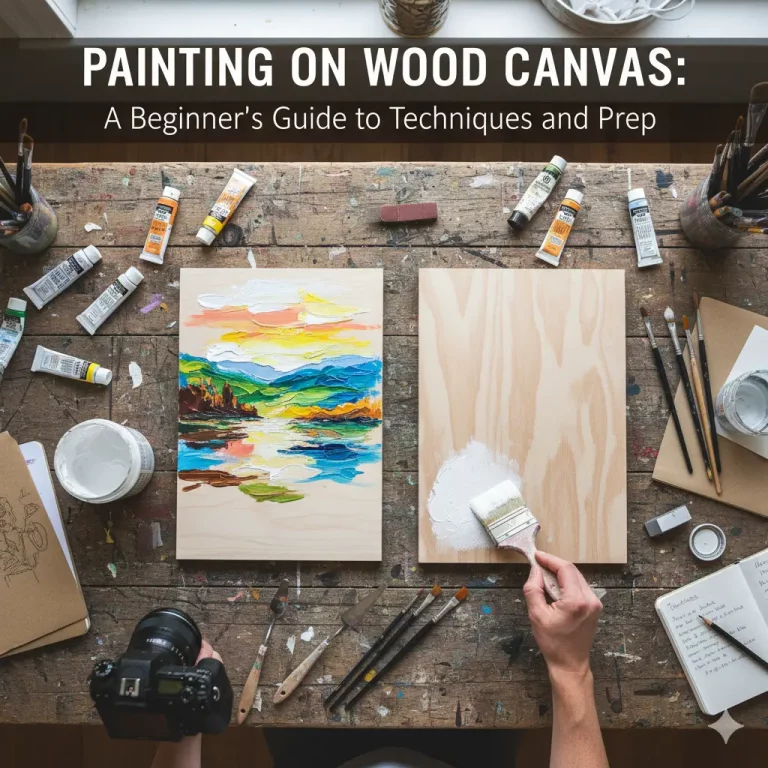A beautiful piece of canvas art can transform a room, but the right frame elevates it from just a painting to a masterpiece. Framing does more than protect your art; it completes it. A well-chosen frame enhances the colors, complements the style, and integrates the artwork seamlessly into your home’s decor. But with so many options, where do you begin?
This guide will walk you through everything you need to know about framing canvas art. We will explore different frame styles, discuss common materials, and share expert tips for choosing and hanging your art. You will learn how to make your canvas a true focal point.
Understanding Frame Styles for Canvas Art
The style of the frame is your first big decision. It should align with both the artwork’s aesthetic and your personal taste. From modern to traditional, each style offers a unique look.
The Modern Minimalist: Floating Frames
For a clean, contemporary look, the floating frame is a popular choice. This style creates the illusion that your canvas “floats” within the frame, with a small gap between the canvas edge and the frame’s inner lip. This separation adds depth and sophistication, making the artwork itself the star. Floating frames are perfect for abstract, modern, and minimalist art. They let the piece breathe without being constrained by a traditional border.
If you’re considering this sleek option, it’s important to get the installation just right. Our detailed guide can help you How to Choose and Hang the Perfect Floating Frame for Your Canvas.
The Classic Choice: Traditional Frames
Traditional frames, often more ornate and decorative, are ideal for classic art like portraits, landscapes, and still life paintings. These frames can feature intricate carvings, gilded finishes, and wider profiles. A gold-leafed frame can add a touch of luxury to a formal living room, while a rustic wood frame might be perfect for a country-style home. The key is to match the frame’s character to the artwork’s mood.
When selecting a frame, think about the overall design. Sometimes, what makes a frame perfect isn’t its complexity but its simple elegance. Explore our guide on What Makes a Photo Frame Beautiful? A Design Guide to find your perfect match.
Telling a Story: Collage Frames
Why display one memory when you can show several? Collage frames allow you to group multiple images or small canvases into a single, cohesive display. This is a wonderful way to tell a story, whether it’s chronicling a family vacation or showcasing a series of small abstract paintings.
Collage frames come in many configurations, from simple grids to more eclectic layouts. For instance, a 4 collage photo frame can be a versatile tool for creating a balanced and beautiful wall arrangement. If you need more inspiration, check out these 15 Inspiring Collage Frame Ideas for Your Family Photos.
Choosing the Right Materials for Your Frame
The material of your frame impacts its durability, weight, and overall aesthetic. Wood and metal are the most common choices, each with distinct advantages.
Wood Frames: Warmth and Versatility
Natural beauty and warmth are the hallmarks of wood in art. It’s available in a wide variety of types and finishes, from light maple and pine to rich walnut and mahogany.
- Oak: Known for its strength and prominent grain, perfect for a rustic or traditional feel.
- Pine: A lightweight and affordable option that can be easily stained or painted.
- Walnut: A darker, more luxurious wood that adds a sense of formality and elegance.
Wood frames are incredibly versatile and can be adapted to almost any art style. They are especially fitting for art on a wood canvas, creating a cohesive, nature-inspired look. If you’re interested in exploring more creative frame options, don’t miss our guide on Where to Find Free HD Frame Designs for Your Digital Projects for useful digital resources and design inspiration.
Metal Frames: Sleek and Durable
Metal frames, typically made from aluminum, offer a sleek and modern alternative to wood. Due to their lightweight, durable, and warp-resistant qualities, they are ideal for large canvases or high-humidity areas like bathrooms. There are a variety of metal frame finishes available, including matte black, silver, gold, and brushed pewter, which pair exceptionally well with contemporary art, photography, and posters.
For those looking for unique designs, thinking outside the box can lead to stunning results. Discover some unconventional options in our article on 12 Creative Photo Frame Designs.
Tips for Framing Different Types of Canvas
Not all canvases are created equal. Whether you’re framing a traditional stretched canvas, a canvas sheet, or even a hand-painted original, the approach can differ.
Stretched Canvas vs. Canvas Sheets
A stretched canvas is already mounted on a wooden frame (stretcher bars), making it ready for a floater or traditional frame. A canvas sheet, however, is a flat piece of primed canvas fabric. It needs to be mounted onto a rigid backing board before it can be framed, much like a paper print. This makes it a versatile option for artists who want to customize their sizing.
Artists often buy canvas in bulk to save money. If you’re an artist yourself, understanding material costs is crucial. Our buyer’s guide on Understanding Canvas Roll Prices can help you make an informed purchase.
Framing Hand-Painted and Valuable Art
When framing a valuable piece, such as a hand-painted canvas, protection is as important as presentation. Opt for archival-quality materials to prevent damage over time. Consider adding UV-protective glass or acrylic to shield the art from fading due to light exposure. While traditional oil and acrylic paintings on canvas are often displayed without glass, it can be a wise addition for delicate or valuable works.
Framing for Modern Spaces: Square Canvases
Modern and minimalist spaces often benefit from unique display choices. Square canvases, for instance, are gaining popularity for both contemporary art and social-media-friendly displays. Discover why this shape is so effective for both modern art and Instagram-worthy prints in our blog Why Square Canvases are Perfect for Modern Art and Instagram Prints.
How to Choose the Perfect Frame: A Step-by-Step Guide
- Assess Your Artwork: What is the style, color palette, and mood of the canvas? A busy, colorful painting may benefit from a simple, neutral frame, while a minimalist piece might handle a more ornate one.
- Consider Your Decor: Where will the art hang? The frame should act as a bridge between the artwork and your room’s style. Match materials or colors to existing furniture and finishes for a cohesive look. A prominent piece in an entryway might need a different approach than a small piece in a bedroom. Find tips for your space in our guide to choosing the best photo frames for your hallway or entryway.
- Think About Proportions: The width of the frame should be proportional to the size of the canvas. A large, heavy frame can overwhelm a small canvas board painting, while a thin frame might look flimsy on a massive piece of art.
- Set a Budget: Frame prices vary widely. Decide how much you are willing to spend. Custom framing offers the most options but comes at a higher cost, while ready-made frames are more budget-friendly.
Your Art Deserves the Perfect Frame
Choosing a frame for your canvas art is a creative process in itself. It’s the final touch that honors the artist’s work and brings your personal style to life. With consideration for the art, your decor, and the styles and materials available, you can select a frame that you will love for years to come.
Ready to start your next art project? Explore our range of custom canvas prints and framing options to turn your favorite photos and designs into beautiful works of art.





